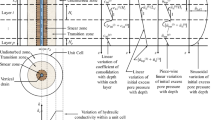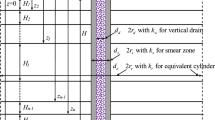Abstract
Consolidation of problematic soils such as soft or compressible soils with high clay content can be overcome by preloading along with Prefabricated Vertical Drains (PVDs) which is one of the most common techniques used over the past few years. Parameters that influence consolidation or rate of settlement at the site are coefficient of consolidation for horizontal/radial flow, smear effects such diameter of and permeability of remolded or disturbed soil in the smear zone. In this paper, degree of consolidation at the end of construction (Utc), final settlements, SfA, from Asaoka plots for degree of consolidation with time factor, under ramp loading with smear effects (s), the ratio of diameter of smear zone to that of drain, and kh/ks, the ratio of permeability on in situ soil to that of soil in the smear zone), have been developed for different unit cell diameter ratios, n, and time factors, Tc, corresponding to end of construction. A new method for the estimation of in situ parameters such as Cr, s and kh/ks of the smear zone from the in situ measured time-settlement plot, is proposed.
Access provided by Autonomous University of Puebla. Download conference paper PDF
Similar content being viewed by others
Keywords
- PVDs
- Consolidation parameters
- Unit cell
- Smear
- Degree of consolidation at the end of construction
- Asaoka method
1 Introduction
Soft soils are often encountered along coastal regions, swampy areas, and deltas all over the world, because of which construction of any infrastructure project on such soils is indeed a challenge. Consolidation of soft soils is mostly achieved through vertical drains which are coupled with preloading. Based on the one-dimensional consolidation theory, Asaoka [1] proposed a new approach to evaluate the coefficient of consolidation for vertical flow, cv along with final settlement, Sf. Case history of Changi East Reclamation, Singapore comprising of vertical drains coupled with preloading was studied and presented by Arulrajah et al. [2]. Chung et al. [3] presented various case studies which are associated with vertical drains with preloading like Chek Lap Kok airport, Busan Airport, and Changi airport in their research work. Adverse effects such as smear and permeability ratio affect the consolidation in an unfavorable manner by delaying the settlement rate. So, it is important to estimate these parameters that affect the consolidation rate and time in soft soils. The objective of the paper is to analyze and estimate the in-situ consolidation parameters smear ratio (s), permeability ratio (kh/ks) and coefficient of consolidation (Ch) from the available time-settlement data. Monitored data of time-settlement data from Indraratna et al. [4] are analyzed and presented.
2 Methodology
Theoretical values of degree of consolidation, Utc, at the end of construction are obtained from Olson [5] for the consolidation with flow in the radial direction for ramp loading as
where
diameter ratio, n = de/dw, de and dw are the diameters of the drain well and influence zone respectively, smear ratio, s = rs/rw, rs and rw are the radii of smear zone and drain well, respectively, Tr = cr ⋅ t/de2—dimensionless time factor, Tc = cr ⋅ tc/de2—dimensionless time factor for time, tc, at the end of construction, F(n)—function of n and s, kh/ks—permeability ratio and A = 20/F(n). Tc is calculated from the Eq. 1 with Tr = Tc for different diameter ratios and different smear ratios. Knowing Tc, the coefficient of consolidation, cr for flow in radial direction is determined as
Time-settlement plots are shown in Fig. 1 of different sections from Indraratna et al. [4] who demonstrated the effectiveness of vacuum coupled surcharge loading system over conventional surcharge loading. All the curves from time versus settlement are digitized and analyzed for different time intervals.
Time-settlement plot of staged construction (after Indraratna et al. [4])
In the new method, Final settlements, SfA are estimated from the digitized data of time-settlement plots for different sections based on Asaoka [1]. Based on the settlement, Sc corresponding to the time at the end of first stage of ramp loading, tc, the degree of consolidation, Utc, at the end of construction is estimated for different diameter ratios, n. Utc is plotted with respect to ‘s’, and smear ratio is interpolated corresponding to ‘n’ Utc is also plotted against Tc for different smear ratios, s. For a given ‘n’, Tc is obtained through interpolation. Same procedure is repeated for determining the permeability ratio, kh/ks and the corresponding Tc. The estimated coefficients of consolidation are compared with those of Indraratna et al. [4]. Details such as drain type, diameter of drain well (dw), equivalent diameter of the influence zone (de), spacing between the drains (S), diameter ratio (n), time at the end of construction (tc) for the sections from Indraratna et al. [4] are extracted from Fig. 1.
3 Case Study
Indraratna et al. [4] compared time-settlement responses between consolidation with vacuum surcharge preloading and conventional surcharge loading at seven different sections and found that consolidation due radial flow is faster and lateral displacements are less in the former (vacuum surcharge loading) than the latter. In this study, typically, two types of drains i.e., circular and band-shaped (100 × 4)mm with spacing of the drains ranging between 1.1 and 1.3 m were used. Drains were laid in square pattern and the diameter of equivalent influence zone/unit cell, de, is obtained. The parameters are listed in Table 1.
3.1 Validation
The proposed method is applied and validated for different sections mentioned in Indraratna et al. [4]. A typical Asaoka plot for section VC1 is shown in Fig. 2 with diameter ratio, n of 36 with spacing, S as 1.1 m. The final settlement, SfA is obtained as 1.2 m.
Figures 3, 4, 5 and 6 show plots were drawn between Utc and s for diameter ratio (n) varying between 10 and 40 for different time factors, Tc, at the end of construction. In a similar way, plots for different ‘Tc’ values for varying ‘n’ are drawn. ‘s’ is estimated through interpolation with ‘n’ corresponding to the obtained Utc value.
Figure 7 is a typical plot between time factor, Tc, and degree of consolidation, Utc, at the end of construction for diameter ratios (n) ranging from 10 to 40 for smear ratio, s = 2. For different diameter ratios, similar plots are drawn for ‘s’ varying from 2.5 to 3.5. Tc is obtained through interpolation for a given ‘s’, corresponding to the obtained Utc and for the known ‘n’ value.
Figures 8, 9, 10 and 11 show typical plots drawn between Utc and kh/ks for different diameter ratios (n) varying between 10 and 40 for different time factors, Tc, at the end of construction, Similarly, plots for different ‘Tc’ for varying ‘n’ are drawn. ‘kh/ks’ value is estimated through interpolation of ‘kh/ks’ with ‘n’ corresponding to the obtained Utc value.
Figure 12 is a typical plot drawn between time factor, Tc, at the end of construction and degree of consolidation, Utc, at the end of construction for diameter ratios (n) ranging from 10 to 40 for permeability ratio, kh/ks = 2. Similar plots are drawn for ‘kh/ks’ values varying from 2.5 to 3.5 for varying diameter ratios. Tc is estimated for a given ‘kh/ks’, through interpolation of Tc and n corresponding to Utc.
Results obtained are tabulated in Tables 2 and 3. Utc is obtained from settlement, Sc corresponding to the time, tc, at the end of first construction loading and final settlement. Smear ratio and time factor at the end of construction are estimated or determined from Figs. 3, 4, 5, 6 and 7. The coefficient of consolidation, cr Tc is determined from Eq. 3. Similarly, permeability ratio, kh/ks, and the corresponding time factor, Tc at the end of construction are from Figs. 8, 9, 10, 11 and 12. The coefficient of consolidation, cr Tc, is calculated from Eq. 3.
Ratio of coefficient of consolidation (cr Tc) to the coefficient of consolidation, cr (from Indraratna et al. [4]) ranges between 0.8–1.4 and 0.7–1.4 for different permeability and smear ratios (Table 3).
4 Conclusions
As a well-known fact, vertical drains coupled with preloading is an efficacious method to expedite the consolidation by promoting radial flow. In this paper, the crucial factors that control the performance of vertical drains including the phenomenon of smear zone along with the permeability ratio were discussed. A new method to estimate the in-situ parameters, viz., smear ratio (s), permeability ratio (kh/ks) and coefficient of radial consolidation (cr) from the time versus settlement plots is proposed. The proposed method is analyzed and illustrated through a well-documented case history, reported by Indraratna et al. [4]. Time factors, Tc, at the end of construction obtained from the plots corresponding to smear (s) and permeability (kh/ks) ratios are nearly the same. The coefficients of radial consolidation (cr Tc) obtained from both the approaches are close and compare well with those of Indraratna et al. [4].
References
Asaoka, A.: Observational procedure of settlement prediction. Soils Found. 18(4), 87–101 (1978)
Arulrajah, A., Bo, M.W., Chu, J., Nikraz, H.: Prefabricated vertical drains to the Changi land reclamation project, Singapore. In: Proceedings of 4th Asian Regional Conference on Geosynthetics, pp. 651–655 (2008)
Chu, J., Bo, M.W., Chao, V.: Practical considerations for using vertical drains in soil improvement project. Geotext. Geomembr. 22(1), 101–117 (2003)
Indraratna, B., Rujikiatkamjorn, C., Xueyu, G., Ameratunga, J., Peter.: Performance and prediction of vacuum combined surcharge consolidation at port of Brisbane. In: Sydney Chapter Symposium Australian Geomechanics Society, pp. 45–60 (2011)
Olson, R.E.: Consolidation under time dependent loading. J. Geotech. Eng. Div. Proc. ASCE 103(GT1), 55–60 (1977)
Author information
Authors and Affiliations
Editor information
Editors and Affiliations
Rights and permissions
Copyright information
© 2022 The Author(s), under exclusive license to Springer Nature Singapore Pte Ltd.
About this paper
Cite this paper
Ande, S., Nageshwar Rao, C., Madhira, M. (2022). Relationship Between Various Consolidation Parameters of Compressible Soils. In: Satyanarayana Reddy, C.N.V., Muthukkumaran, K., Satyam, N., Vaidya, R. (eds) Ground Characterization and Foundations. Lecture Notes in Civil Engineering, vol 167. Springer, Singapore. https://doi.org/10.1007/978-981-16-3383-6_17
Download citation
DOI: https://doi.org/10.1007/978-981-16-3383-6_17
Published:
Publisher Name: Springer, Singapore
Print ISBN: 978-981-16-3382-9
Online ISBN: 978-981-16-3383-6
eBook Packages: EngineeringEngineering (R0)
















